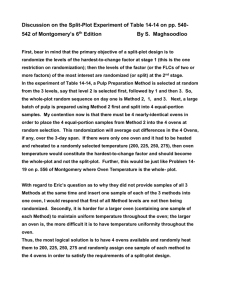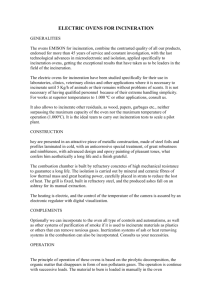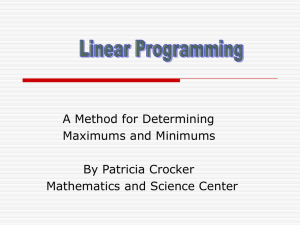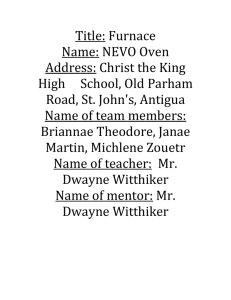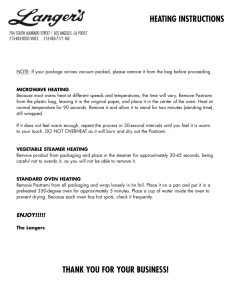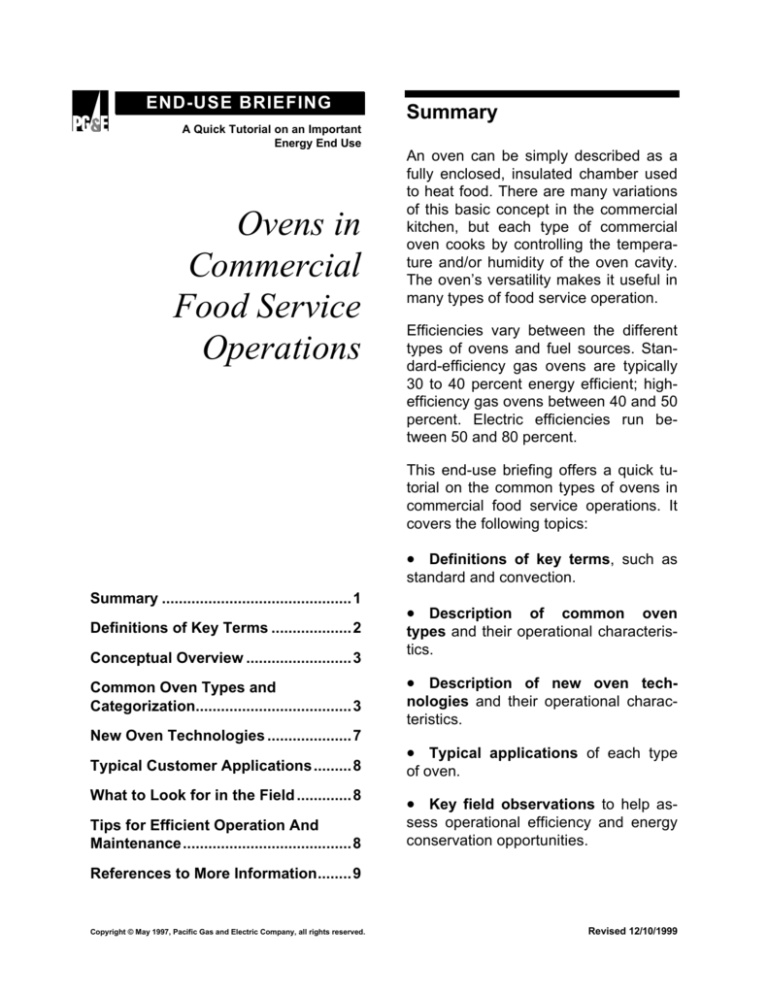
END-USE BRIEFING
Summary
A Quick Tutorial on an Important
Energy End Use
Ovens in
Commercial
Food Service
Operations
An oven can be simply described as a
fully enclosed, insulated chamber used
to heat food. There are many variations
of this basic concept in the commercial
kitchen, but each type of commercial
oven cooks by controlling the temperature and/or humidity of the oven cavity.
The oven’s versatility makes it useful in
many types of food service operation.
Efficiencies vary between the different
types of ovens and fuel sources. Standard-efficiency gas ovens are typically
30 to 40 percent energy efficient; highefficiency gas ovens between 40 and 50
percent. Electric efficiencies run between 50 and 80 percent.
This end-use briefing offers a quick tutorial on the common types of ovens in
commercial food service operations. It
covers the following topics:
• Definitions of key terms, such as
standard and convection.
Summary ............................................. 1
Definitions of Key Terms ................... 2
Conceptual Overview ......................... 3
Common Oven Types and
Categorization..................................... 3
New Oven Technologies .................... 7
Typical Customer Applications ......... 8
What to Look for in the Field ............. 8
Tips for Efficient Operation And
Maintenance........................................ 8
• Description
of common oven
types and their operational characteristics.
• Description of new oven technologies and their operational characteristics.
• Typical applications of each type
of oven.
• Key field observations to help assess operational efficiency and energy
conservation opportunities.
References to More Information........ 9
Copyright © May 1997, Pacific Gas and Electric Company, all rights reserved.
Revised 12/10/1999
• References to other documents that
provide detailed information on the topics in this briefing.
induced in the oven cavity by fans or
blowers.
• Indirect Fired: Describes gas ovens
• Air Impingement: Jets of air are directed onto the food product using a
ported manifold.
which route the combustion products
around the bottom, sides and top of the
oven without entering the cooking cavity. The oven cavity walls of indirect
fired ovens become hot and heat is
transferred to the food by either convection or forced convection.
• Atmospheric Burner: A burner
• Idle Energy Rate: The rate at which
Definitions of Key Terms
which jets gas and air through a hole
(“burner port”) at which point it mixes
and is ignited. This “Bunsen” type
burner shows a blue flame when properly adjusted.
• Conduction: A cooking process in
which heat is transferred to the food via
direct contact with a heated medium
(e.g., ceramic hearthstone, firebrick or
composite hearth.)
• Convection: A cooking process in
which currents of hot air transfer heat to
the surface of the food. Convection ovens use fan(s) to circulate hot air in the
oven cavity.
• Cooking Energy Efficiency: The
ratio of the quantity of energy absorbed
by the specified food to the quantity of
energy input to the oven during a cooking energy efficiency test, expressed as
a percent.
an empty oven uses energy to maintain
its cavity temperature at the thermostat
set point (e.g., 350ºF).
• Infrared Burner: A burner made of
porous ceramic plates or metal screens.
Combustion of premixed air and gas
takes place on the burner surface,
which can reach 1800ºF. The high surface temperatures cause the material to
emit radiant heat. Up to 50 percent of
the energy in the gas can be converted
to radiant heat.
• Natural Convection: Convection
created in the oven cavity due to the
natural movement of hot air heated by
burners, elements or heated cavity walls
(i.e., without the use of fans or blowers).
• Oven Capacity: Maximum amount
of food that can be cooked at one time
(e.g., 6 12”-diameter pizzas, 40 pies,
20 to 40 sheet pans).
• Direct Fired: Describes gas ovens
• Oven Cavity: The cooking zone,
which route the combustion products
from the burners through the cooking
cavity, transferring heat directly to the
food from the hot gases.
chamber or compartment in an oven.
• Forced
Convection:
Convection
©
• Radiant heat: Hot surfaces emit radiant heat. In ovens, the heat radiated
by burners, elements or the heated cavity walls moves towards the food.
PG&E Energy Efficiency Information “Ovens in Food Service Facilities”
Page 2
• Rated Input: (Also “Nameplate Input”) The maximum rate of energy consumption for an appliance.
Conceptual Overview
Commercial ovens are available for use
with gas, electricity or liquid propane
and come in many sizes.
An oven heats food by surrounding it
with hot air. Heat is transferred to the
food via convection, conduction, radiation and steam, either singularly or in
combination. In standard ovens the
burners or elements heat the air inside
the cavity causing natural convection
currents which transfer heat to the surface of the food. What the industry calls
a “convection” oven employs motorized
fans or blowers to create forced convection currents in the cavity; this cooks
the food faster while maintaining uniform heating.
Heat may be transferred to a oven either indirectly or directly. In indirect-fired
ovens, the hot combustion products of
the gas heat the bottom, sides and top
of the oven without entering the cooking
cavity. In direct gas-fired ovens the hot
combustion products are directed
through the cooking cavity rather than
around the cavity. Heat is transferred
directly from the hot gases to the food.
Common Oven Types and
Categorization
Ovens fall into two common categories:
standard (or natural convection) and
forced convection. Standard and forced
©
convection ovens are divided into sub
categories (rack, combination, conveyor, rotisserie, etc.). The matrix in
Table 1 presents the characteristics of
each sub category, along with common
use and customer application.
Standard
Standard ovens use natural convection
(hot air currents) and radiant heat to
cook food products. These ovens can
be used for nearly all types of food
preparation. Because they do not use
blowers or fans to move air inside the
oven cavity, standard ovens are used
for precision-baking sensitive pastry
products such as meringues, cream
puffs and pastry shells. Standard ovens
are the least expensive to purchase, but
they are not as fast-cooking or flexible
as forced convection ovens.
Standard ovens usually have simple
controls, limited to a thermostat and a
selector that allows the oven to bake or
broil. Modulating thermostats, which
adjust the burner incrementally, are
most common.
Range Oven
The most common standard oven is the
range oven. Range ovens are part of
the base of a rangetop, and are the familiar type of oven seen in most residential applications.
Gas range ovens are heated with atmospheric gas burners located directly
below the oven cavity. The flue gases
are routed around and/or through the
cavity. In electric ovens the elements
are placed in the top and bottom of the
oven cavity, where they add both radi-
PG&E Energy Efficiency Information “Ovens in Food Service Facilities”
Page 3
ant and convective heat; they also may
be placed underneath the oven cavity.
Deck Oven
These ovens have a flat, wide cavity.
The floor of the cavity is referred to as a
deck, and it is usually possible to place
pans or the food product itself directly
on the deck surface. These ovens are
usually freestanding, and may consist of
one to four stacked compartments.
Compartment size and construction
vary. Manufacturers list deck ovens by
intended use. Baking and roasting compartments may be combined into one
oven with multiple cavities; the baking
compartments are about half the height
of roasting compartments (7” vs. 15”).
Specialized deck ovens for baking pizza
may have modified decks and/or dampers to adjust temperature.
Deck ovens also can be used to cook a
wide variety of other foods; the limiting
factor is the height or thickness of the
food product.
Convection
Convection ovens force air through a
motorized fan (or blower) which blows
heated air throughout the oven’s cavity.
The speed of the fan affects cook time
and uniformity, as does the pattern of
airflow through the interior. Gas convection ovens are available with single
or multiple burners. Burners are usually
located at the bottom of the oven cavity,
or between the cavity and the insulated
oven wall. Until recently, most gas convection ovens have used atmospheric
rather than infrared burners.
Most gas convection ovens are indirect©
fired. Manufacturers differ in how they
route the flue gases and how they mix
them with cavity air. Gas burners may
be protected from air currents by an arrangement of baffles, and the flue gases
directed around or through the cavity.
Alternatively, the flames and flue gases
may be directed into tubes that act as
heat exchangers and vent into the flue.
Forced convection ovens come in fullsize or half-size capacities, depending
on whether they are dimensioned to accept standard full-size 18 x 26 x 1” or
half-size 18 x 13 x 1” sheet pans. Fullsize ovens have large interior cavities
capable of handling up to six full-size
pans. Half-size models accommodate
up to five half-size pans. Countertop
and range type convection ovens are
also available, as are high-capacity rollin or rack ovens. The convection principle has also been applied to conveyor
and rotisserie ovens.
In general, convection ovens offer more
control over cooking than standard ovens. Convection ovens generally use
accurate electronic sensors and thermostats. Many gas models feature
electronic ignition and controls. Also,
most of the newer gas and electric
models have programmable cooking
computers. Some ovens allow the user
to control cooking by regulating fan
speed as well as temperature, humidity
and cooking time.
Rack Oven
Rack ovens are tall stainless steel
boxes. The rack oven is capable of producing uniformly cooked products in
high volume. They typically have a capacity of 20 to 40 standard sheet pans.
PG&E Energy Efficiency Information “Ovens in Food Service Facilities”
Page 4
Standard
Oven Type
Range
Convection
Rack
Combination
Conveyor
Rotisserie
Deck/Pizza
Gas or
Electric
Gas and
Electric
Gas and
Electric
Typically
Gas
Gas and
Electric
Gas and
Electric
Gas and
Electric
Gas (kBtu/h)
35 - 45
20 - 120
15 - 100
125 - 375
68 - 212
120 -150
40 - 60
Electric (kW)
7-9
6 - 12
2 - 40
10 - 63
35 - 45
4 - 12
Typical
Capacity/
Dimensions
1 Cavity
36” wide x
30” deep x
30” high
1-3 Cavities
7” - 15” high
Full-Size: 6
sheet pans
Half-Size: 6
sheet pans
1 Cavity
20 - 40
sheet pans
1 Cavity
Varied sizes
1-3 Units
Varied
sizes
1 Cavity
Varied sizes
Heat Transfer
Method
Natural
Convection
Natural
Convection
Forced
Convection
Forced
convection
Forced
Convection
Forced
Convection
Forced
Convection
Radiant Heat
Radiant Heat
Radiant Heat
Radiant
and Conductive
Heat
Radiant Heat
Radiant
Heat
Radiant
Heat
Fuel Source
Typical Input
Rates:
Conduction
Steam
Natural
Convection
with Conduction
Steam
Common
Use
Baking and
roasting a
variety of
food. Ideal for
precision
baking.
Baking and
roasting a
variety of
food. Ideal
for baking
and pizza.
Baking and
roasting a
variety of
food.
Baking
and
roasting or
reheating
a variety
of food.
Multi-purpose
for a variety
of food:
Baking
Roasting
Broiling
Steaming
Primarily
used for
pizza.
Cook and
market a
variety of
foods. Primarily used
for chicken.
Customer
Application
Normally
specified for
smaller
operations
Pizza operations, bakeries, hotels,
hospitals,
cafeteria
kitchens
Bakeries,
chain restaurants, hotels,
hospitals,
cafeteria
kitchens
Highvolume
operations
Institutional,
restaurants,
kiosks and
Supermarkets
Highvolume,
limited
menu operations
Chain restaurants
and Supermarkets
Table 1: Oven Types, Common Uses and Typical Customer Applications
©
PG&E Energy Efficiency Information “Ovens in Commercial Food Service Operations”
Page 5
Pans are loaded into a metal rack which
is rolled into the oven. Inside the oven,
a motorized lift revolves the rack for
even cooking. Rack ovens use forced
convection and many have the ability to
inject steam into the cavity to enhance
shine and crust on baked goods.
and speed of the conveyor. Newer conveyor oven designs may incorporate
multiple cooking zones within the cooking chamber, with three cooking zones
being typical. Some conveyor ovens
have a hinged glass door along side of
the chamber to allow loading and unloading of food.
Combination Oven
Combination ovens are convection ovens that include a steam generator. The
oven can be operated as a convection
oven, as a pressureless steamer, or in
“combination” mode.
Combination ovens can hold either traditional sized half- and full-sized sheet
pans or steam pans. They start with
smaller countertop or half-size models,
move towards full-size combination ovens and extend to large, floor-mounted,
full-sized units that accept up to 20
standard full-size sheet pans. Large capacity roll-in rack models are also available.
Electric combination ovens dominate
the market place, however recently several manufacturers have introduced gas
alternatives. Many gas models are now
available.
Conveyor Oven
Essentially, conveyor ovens are a rectangular housing containing a baking
cavity or chamber which is open on the
two opposite sides. A conveyor system
carries the product through the baking
chamber on a wire rack. Some conveyor
ovens can be outfitted with multiple
conveyors so that products may be sent
through the oven at different speeds.
Oven controls adjust both the heat input
©
Conveyor ovens are available using
four different heating processes: infrared; natural convection with a ceramic
baking hearth; forced convection; or a
combination of infrared and forced convection. The ovens are available in
many different sizes and configurations.
Most ovens can be stacked up to three
units high, significantly increasing production capacity without requiring increased floor space. Gas leads in this
market.
Rotisserie Oven
Rotisserie ovens are designed for batch
cooking, with individual spits arranged
on a rotating wheel or drum within an
enclosed cooking cavity. The heat
source may be a gas burner or electric
elements, and some rotisseries incorporate high-wattage quartz lamps for display and/or browning.
For gas rotisserie ovens a number of
gas-fired burner systems are available.
Single heat-source systems include atmospheric flame type, radiant and infrared. There also are dual burner systems
that combine infrared with an open
flame and radiant heat. Most gas models feature electronic ignition systems.
Rotisserie ovens range in size from
high-volume floor models to spacesaving countertop models. Most models
are equipped with basic time and tem-
PG&E Energy Efficiency Information “Ovens in Commercial Food Service Operations”
Page 6
perature controls, optional cook-andhold controls, or more sophisticated
control packages with programmable
channels.
State-Of-The-Art
Oven Technologies
Infrared Burners
More efficient infrared burners are replacing the traditional atmospheric
burners in gas ovens. An infrared/forced
convection oven combines the penetrating heat of infrared radiation with
convection to sharply reduce baking
time compared to natural convection
ovens.
Air Impingement
Air impingement is a relatively new
technology applied to conveyor and
some rotisserie ovens. Air impingement
typically uses a ported manifold to direct
jets of air, or “fingers,” onto the product’s surfaces. The “fingers” of air blow
away the layer of air and moisture that
insulates the food, thus increasing the
speed of the cooking process
Quartz Halogen Lamps
Quartz halogen lamp ovens use a combination of infrared energy and visible
light to cook food. The ovens use radiant heat to brown and crisp the exterior
as would a conventional oven. The
lamps start heating instantly, thus have
no preheat time, and remain off when
the oven is in idle mode.
©
Conduction
A recent entry into the market place is
an electric cook-and-hold conduction
oven which circulates heat transfer fluids through the oven’s heat transfer
plates. The heat is conducted directly
through the pans to the food. This
method of heat transfer, according to
the manufacturer, allows food to be
brought evenly to a cooked state without burning or drying.
Combination Convection
Microwave
A few oven manufacturers are using a
modified impingement system that propels hot air directly down onto the food,
then pulls it around and underneath the
product. This oven is frequently supplied with a built-in microwave to further
speed the cooking process.
Some manufacturers are combining
“smarter controls” with the ovens that
use air impingement and microwave
cooking technologies. Among the innovations are computer-controlled focusing of the hot-air impingement above
and below; a non-rotating cooking
service, which means that the whole
oven can be used to prepare food; and
an innovative microwave technology
which will permit the use of metal trays
and pans.
A large microwave oven manufacturer is
being touted as producing the first
commercially approved compact oven
for food service use. It packs a “double
whammy”, offering 1000 watts of microwave energy and 2,200 watts of convected air. With this combination comes
a host of usage options: browning,
PG&E Energy Efficiency Information “Ovens in Commercial Food Service Operations”
Page 7
baking, steaming, sautéing, cooking and
roasting.
determine if the steam mode is used
and if so, for which food products?
•
Nameplate rating: Energy input
ratings on the nameplate of range
ovens typically list the combined input of the range oven with the burners or elements comprising the
range top.
•
Oven sized to match production
volume: Oversized oven capacity
can cost the facility money by wasting both energy and space.
Typical
Customer Applications
Operators specify ovens based on a variety of factors including its function and
versatility, production capacity, temperature uniformity, and first cost. Table
1 shows the typical applications of ovens in food service operations.
What to Look for
in the Field
Tips for Efficient Operation
• Turn it off: Because it can take up
•
Preheat Time: Most ovens require
preheating for half an hour or less.
Ask the operator how long he/she
usually allows the oven to preheat to
determine if there is an opportunity
to minimize the oven on time.
to half an hour to preheat, the oven
can’t be turned off when it is used sporadically. But if you can identify a continuous two-hour period when there is
no use on the oven, the operator can
save up to $400 each year by turning it
off every day during that period.
•
First use: Is there a regular time
each day when the oven is first used
to prepare food? Note this time as
well as when the oven is usually
turned on.
• Start-up and shut-down schedule.
•
Last Use: Is there a regular time
when the last load of product is prepared? Note this time as well as
when the oven is usually turned off.
•
Long Idle Periods: Note any long
periods (e.g. between last lunch and
first dinner prep) when the oven is
idle for two or more hours.
•
Food Product: What foods are
cooked in each oven, and at what
settings? For combination ovens,
©
Sometimes employees simply walk
down the line of appliances in the
morning, turning on every one, hours
before they may be needed. Identify
when the appliance is first used in the
morning, and turn it on just long enough
beforehand to allow for an appropriate
preheat.
Likewise, turn the oven off after its
last use of the day, not some time later
as part of cleanup. Turning an oven off
for an extra hour each day can mean
savings of $40-$200 a year, depending
on the oven.
• Don’t use steam if you don’t need
it: Often combination ovens are used in
PG&E Energy Efficiency Information “Ovens in Commercial Food Service Operations”
Page 8
combination mode (i.e., forced convection plus steam) when convection mode
would be just as effective. Vaporizing
water for steam may increase the energy use of these ovens by as much as
100%.
Convection Ovens” prepared for the
Research
and
Development
Department, Report No. 1994.
References to
More Information
1. “Cooking Appliance Performance
Report:
PG&E
Production-Test
Kitchen.” PG&E Research and Development Report No. 008.1-90.8,
May, 1990.
2. "Montague Model SE70AH Gas FullSize Convection Oven: Appliance
Performance in Production." PG&E
Products and Services Report
No.5011.95.21, 1995.
3. "Montague Model SEK15AH Electric
Full-Size
Convection
Oven:
Appliance
Performance
in
Production." PG&E Products and
Services Report No.5011.95.22,
1995.
4. "Appliance
Performance
in
Production Blodgett Model DFG-60
Gas Half-Size Convection Oven."
PG&E Research and Development
Report No.008.1-9.11, December,
1992.
5. "Blodgett Model CTB-1 Electric HalfSize Convection Oven: Appliance
Performance in Production." PG&E
Products and Services Report
No.5011.95.17, 1995.
6. “Development and Application of a
Uniform Testing Procedure for
©
PG&E Energy Efficiency Information “Ovens in Commercial Food Service Operations”
Page 9


